#tropical butterwort
Text



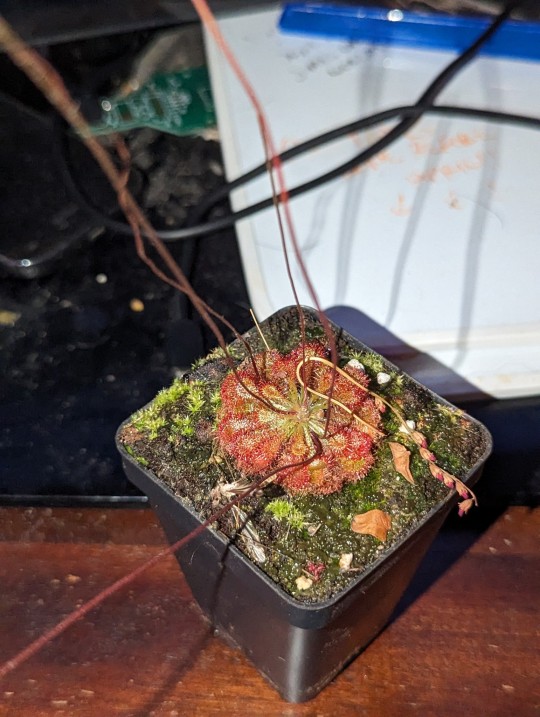
I thought my carnivorous plants would make a great first post!
Top left, purple pitcher
Top right, common butterwort
Bottom left, cape sundew
Bottom right, spoon leaf sundew
Carnivorous plants have always been one of my special interests. I'm just so fascinated by them! I've had Venus fly traps in the past, other pitchers. I actually have another pitcher, a velvet pitcher, but it's not doing so hot. I got it discounted, and I think the seller may have been feeding it tap water instead of distilled, and she wasn't thrilled about having the plant in her shop in the first place because she is vegan. So she ended up giving it to me at a discount because she wanted it out! I'm still trying to revive it, but I'm starting to get less hopeful about it.
#carnivorous plants#house plants#plantblr#plants#pitcher plant#purple pitcher plant#butterwort#tropical butterwort#common butterwort#sundew#cape sundew#spoon leaf sundew
23 notes
·
View notes
Text
wanna test the poll thing..
#most of them i just read from this book called Darwin's Most Wonderful Plants by Ken Thompson#so I just knew about them yet they're SO COOL#hellyea#poll#carnivorous plants#man#i love carnivorous plants#a tribute for my dying nepenthes i'm sorry darling nepenthes..
17 notes
·
View notes
Text
HEY I LOVE CARNIVOROUS PLANTS DO YOU LIKE CARNIVOROUS PLANTS TELL ME WHAT YOUR FAVORITE CARNIVOROUS PLANTS ARE.
#plants#carnivorous plants#polls#like with most polls on this site pls reblog for a larger sample size :)
16 notes
·
View notes
Note
what kind of carnivorous plants do you have??? i wanna get into it but idk where to start
Ooh, yes you should!! It's definitely a little overwhelming to get started though, yeah.
My babies are a Virtue's Victory tropical pitcher plant (N. ventricosa), a King Henry venus flytrap (variant on D. muscipula), a Mexican pinguicula butterwort (P. cyclosecta), a Cape sundew (D. capensis), a North American crimson pitcher plant (S. leucophylla), and a Floating sundew (D. admirabilis) that I'm trying extremely hard to sprout from a seed.
There's a ton of info out there on CPs, but my favorite place for resources, live plants, and care products is California Carnivores. I highly recommend them if you're in the US. Most of their plants come pre-potted in appropriate soil, which is a huge part of CP care (fertilizer-free, low nutrient soil is a must) and they offer heat packs for plant shipping which is really nice.
My suggestion for starter plants are a Cape sundew (would grow in the toilet tbh), a venus flytrap (read up on them though, the average Walmart VFT kit is Not Correct), and maybe a butterwort of some kind. They're very hardy little dudes who will forgive you if there's a learning curve. I wouldn't recommend starting with any pitcher plants. They're extremely dramatic and love to die if you shift them a foot to the left or feed the wrong trap.
Really all you need to start off is a jug of distilled (it HAS to be distilled) water, a tray that you can fill with a couple inches of that water to set the plants in, and an LED grow light. A mister is nice to have, as is some extra CP-friendly sphagnum moss for substrate emergencies, but they aren't necessities.
80% of keeping carnivores alive is doing research ahead of time on each plant and keeping them wet once you get them. They aren't as intimidating as they seem! I hope you give it a go!!
5 notes
·
View notes
Photo


Mexican Pinguicula - pinguicula ehlersiae
Tropical Butterwort
Where to Grow
Grow your tropical butterworts indoors on a sunny windowsill. They appreciate a mild ambient climate, which is why they tend to do exceptionally well for coastal growers. A cool windowsill (between 60-75 deg. F., 15-25 deg. C.) will encourage lush growth as long as they also receive enough sunlight. Humidity is a non-issue - most tropical butterworts appreciate damp soil but too much ambient humidity can cause rot.
Sunlight
Grow your tropical butterwort in direct morning sun and dappled sun during the rest of the day. Avoid the blazing hot afternoon sun during the summer months - this will stress tropical Pinguicula and could cause them to shrink in size.
Artificial Lights
If a sunny window is not possible, use strong fluorescent lights (a minimum of 40 watts in actual output). Start with the lights approximately 12 inches above your plant. Monitor your butterwort's adjustment by watching how healthy any new growth appears, and adjust the height of the light source if you are not satisfied with its growth. Use an electrical timer to maintain consistent daylight hours (14 hours is sufficient throughout the year).
Water
Unlike most other carnivorous plants, tropical butterworts are prone to rotting if the soil is too wet. Keep the soil moist by top watering whenever the top soil begins to feel dry. It's alright to pour water over your plant! Mucilage washed off the leaves will be replaced within the day. Avoid letting the soil dry out completely.
If you prefer, you may keep your plant in small amounts of water, no more than 1/4 of the way up the pot. If you use this method of watering, add more water only when the water evaporates completely from your tray.
Unlike many other types of carnivorous plants, tropical butterworts can tolerate moderate hard water (up to 200 ppm) with almost no adverse change in growth. Make sure the water drains through completely. If you use the water tray method, use low mineral water (less than 50 ppm) to avoid excessive mineral buildup in the soil, which can become harmful at high concentrations for tropical Pinguicula.
Soil
Use a coarse mix of one part sphagnum peat and two parts perlite. Never use potting soil or fertilizer; they will kill your plant.
Winter Growth
Tropical butterworts will produce a tight rosette of smaller succulent-like leaves during winter when days become shorter and temperatures cool down. This type of formation is the plants' way of adapting to winter drought in the wild. They will resume regular growth after a few months.
source for care info
26 notes
·
View notes
Text

Pinguicula flower
8 notes
·
View notes
Text

Pinguicula laueana
#indoor plants#houseplants#house plants#tropical plants#carnivorous plant#butterwort#flowering plants#mexico
32 notes
·
View notes
Text

My carnivorous plant bog! Ft.:
3 sundews (Drosera capensis, D. tokaiensis, and D. madagascariensis)
a tropical pitcher plant (Nepenthes spectabilis x mira)
an Australian pitcher plant (Cephalotus follicularis)
a butterwort (Pinguicula primuliflora)
a terrestrial bladderwort (Utricularia sandersonii)
an aquatic bladderwort (Utricularia gibba)
2 air plants (Tillandsia caput-medusae and T. ????? an fuckin mystery)
a bunch of moss, twigs, and licheny bark from my front yard
an un-chia’d Chia Bob Ross

The 2 tiny moss terrarium on top of the bog
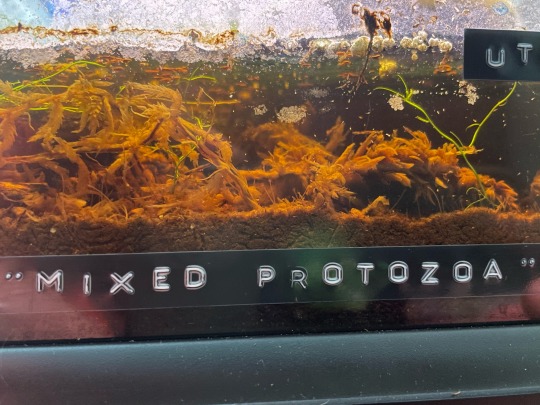
The bog water ft. the critters and the strands of aquatic bladderwort. The only things I put in the water were Daphnia (D. pulex) and whatever is in the “mixed protozoa” from Carolina Biological Supply. The Daphnia are the little white specks. I have what I think are some sort of hydrozoan, the little noodle guys sticking out of the peat at the bottom with a little crown of tentacles at the end. It looks like of them have like, cocooned themselves in the peat or sphagnum and float through the water in their cocoon and reach out and try to grab at the Daphnia with their tentacles occasionally. I also have little tiny roundworms and what look like some sort of flatworm. I’m guessing all these dudes just hitchhiked in on the aquatic bladderwort. I also had some damselflies that mysteriously showed up in the bog a while back; presumably they hitchhiked in as nymphs.
A video of The Critters in action. You can see the Daphnia as little white specks jerking about in the water and what look like hydrozoans wiggling in the peat at the bottom. You can also see what looks like a white flatworm crawling toward the top right of the waterline.
18 notes
·
View notes
Photo



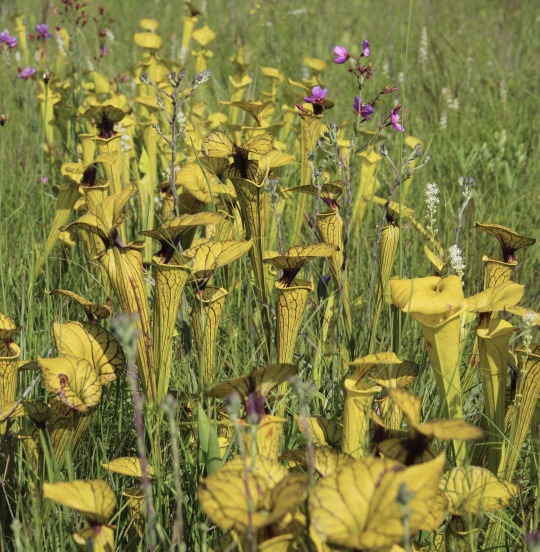
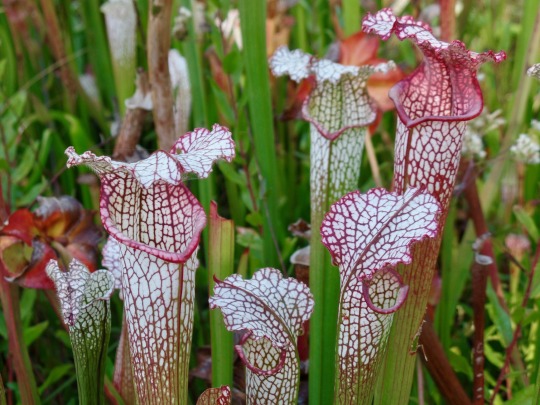




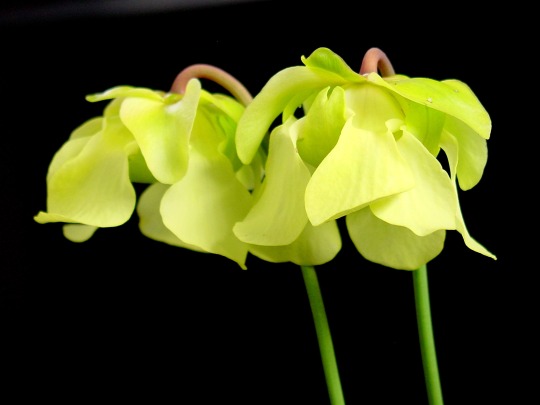
a brief selection of carnivorous plants from my critical role fic the gardener.
these are all north american species, mostly because that’s what I’m familiar with. but there are plenty I haven’t included, even within north america (like the bladderworts and butterworts), but especially further afield (tropical pitcher plants! carnivorous bromeliads! etc). there’s even been some recent research showing that a lot more plants may be carnivorous than we thought, as in the case of the western false asphodel.
photo credits below:
[tracy’s sundew / pink sundew / purple pitcher plant among sphagnum moss / yellow pitcher plant / white pitcher plant / thread-leaved sundew in bloom / mountain sweet pitcher plant in bloom / venus flytrap in bloom / white pitcher plant in bloom / pale pitcher plant in bloom]
important note: never collect carnivorous plants from the wild. make sure any carnivorous plant purchases are from a reputable source and have been cultivated ethically, not wild-poached.
14 notes
·
View notes
Text

Carnivorous grass-types (and skrelp) Gacha adopts!
£16 a roll, £20* to pick one! Evolution/alternate forme designs are an extra £14 each (but may vary a little for stage or complexity)
Treecko/Nepenthes - sold
Applin/Cephalotus - open
Morelull/Drosophyllum - sold
Skrelp/Utricularia - open
Steenee/Sarracenia - sold
Ivysaur/Pinguicula - sold
Leafeon/Heliamphora - sold
Lurantis/Drosera - sold
Serperior/Darlingtonia - sold
Meganium/Drosera - sold
Calyrex/Byblis - sold
Shaymin/Dionaea - open
DM if interested and i’ll shoot you paypal details! You’ll get a full-res unwatermarked image of your design.
more specific Plant Info under the cut because i evidently put more thought into this than i should have:
Tropical pitcher plant/”Monkey cup”, Nepenthes ventricosa
Albany pitcher plant, Cephalotus follicularis
Dewy pine, Drosphyllum lusitanicum
Bladderwort, Utricularia vulgaris
North American pitcher plant, Sarracenia purpurea
Butterwort, Pinguicula moranensis
Sun pitcher plant, Heliamphora nutans
Cape sundew, Drosera capensis
Cobra lily, Darlingtonia californica
Rosette sundew, Drosera natalensis
Rainbow plant, Byblis liniflora
Venus flytrap, Dionaea muscipula
cool/interesting facts about each plant free with purchase (if wanted :))
#adoptables#adopts#pokemon adopts#pokemon adoptables#pokemon oc#pokemon#hope the prices are ok;; i worked hard on these hdghdfgvhdf#i think cobra lily serperior is my favourite#that or butterwort ivysaur#enjoy!!#i left the exact type of plant and scientific name under the cut in case Plant Research is going to be done which i encourage#carnivorous plants are. so cool.#these will also be all going up on toyhou.se for the instabuy price#will keep this post as updated as possible!#and now i take a break from art for a few days bc my wrist hurts and also exams#oof
39 notes
·
View notes
Photo

Drosera glistening in the sun. . . . #drosera #capensis #binata #filiformis #tuberous #butterwort #sundew #sundews #carnivorousplants #carnivorousplantsofinstagram #jeremiahharris #greenhouse #coloradosprings #colorado #flytraps #flytrap #vsco #vscocam #flower #carnivoroustagram #plants #plants #tropical #sticky #stickyplants (at Colorado Springs, Colorado)
#carnivoroustagram#tropical#flytraps#tuberous#sundews#plants#flower#greenhouse#coloradosprings#stickyplants#jeremiahharris#vsco#butterwort#carnivorousplants#capensis#filiformis#drosera#sticky#vscocam#sundew#flytrap#binata#carnivorousplantsofinstagram#colorado
80 notes
·
View notes
Text
Carnivorous Plants and the Things I Know About Them
I've been kicking around the idea of making a post like this and I figured it was of enough general interest to folks on Tumblr to go for it.
So
One of the things I do is grow carnivorous plants, like these




From top left to bottom right we have a Venus Flytrap, a North American Pitcher Plant, a Sundew, and a Butterwort. All of these are pictures I've taken of plants during the growing season.
Now if you look at these weird looking plants you probably wouldn't expect them to be native to North America, but they are. You can find pitcher plants all over the southeast up to the northeast into Canada, flytraps in the Carolinas, and butterworts and sundews all over the continent.
These plants are a lot of fun and easy to grow once you understand their requirements, but before we get into that, I want to take a moment and explain how they came to be in the first place.
To keep it short, carnivorous plants are carnivorous because they grow in soils that are lacking in the nutrients plants need to put out new growth. Because of this, they evolved to find their nutrients a different way - by luring, trapping, and digesting insects. While these plants still photosynthesize, they supplement this with the nutrients they absorb from insects.
Now that we've got that out of the way, I'm going to go into the basics of growing them, point by point. A short disclaimer - I'm specifically talking about temperate North American plants, since they're what I have experience growing. I can provide basic info on how to take care of tropical plants like the southeast asian pitcher plants, but as of this post I don't have experience with them yet.
Soil: For carnivorous plants, a good soil mixture is a must. These plants grow in nutrient-poor marshes, and the soil they call home is constantly wet. The main ingredient in basically any carnivorous plant soil mix is sphagnum peat moss, which is slightly acidic. The second part of the mixture is often perlite or horticultural sand. Some nurseries use a mix of equal parts peat and perlite while others use 80% peat and 20% perlite, but I've had success with both. The most important thing to ensure is that your soil doesn't have any fertilizer added to it. Because carnivores grow in low nutrient soil, any kind of medium that contains fertilizer can actually kill them.
Water: The other vitally important part of the equation (and the one that kills lots of plants when incorrectly applied) is water. Generally, unless your tap water is soft, water carnivores with distilled or reverse osmosis water. The minerals in tap water or even bottled drinking water can eventually build up and kill your plant in the same way fertilized soil does. Carnivores love waterlogged soil, and some even get flooded in nature. To approximate this, set your plant in a tray of water no more than an inch or two high. This ensures your soil stays wet without having to constantly water it.
Containers: Plastic pots are your friend. Avoid terra cotta clay pots, since they can leech minerals into the soil and also tend to dry out your substrate faster. Glazed clay containers can also work. If you're using the tray system, make sure to buy pots with drainage holes, so the water can get in. Also, a trick that lets the water in but keeps the soil from escaping is to line the bottom of the pot with long-fibered sphagnum moss. If you go with an undrained container, make sure to keep the soil wet at all times, but allow some of the water to evaporate in order to keep the water table fluctuating.
Sunlight: Since carnivores evolved their leaves to catch insects, they're pretty poor at photosynthesis. As a result, these plants love sun - the more the better. Many a store bought flytrap has perished as a houseplant due to lack of sun, so if you can, put these plants outside, in the sunniest spot you can. Generally, it's good to give most carnivores around 6 hours of sunlight per day. Many can get by with 4, but they don't often thrive with that amount of light.
Dormancy: Plants that grow in temperate or warm temperate climates tend to buckle down and hibernate during the late fall and winter months, conserving energy until spring. Generally speaking, the large traps die off, or in some cases the plant dies down to the roots, or forms a small bud that rests on the ground. Plants grown outside respond to colder temperatures and shorter photoperiods, while plants grown inside usually need some help. If you're growing your plants on a windowsill or in a terrarium, move them somewhere cold or cut down on their heating, and also diminish the amount of daily light they receive. You can also slow down on watering, though they still need some water to get by.
Temperature: Temperate and warm temperate carnivores can tolerate a wide range of temperatures, despite what you might think. My pots survived the freak snowstorm the Pacific Northwest got this February without a single dead plant. Most species can tolerate temperatures up to 100 degrees Fahrenheit and down to 20 degrees, though not for prolonged periods of time. If you see long spells of hot or cold weather coming, try and move your plants to a protected area until they pass.
Feeding and Fertilizing: Now I know what you're thinking. Fertilizer? He just told us that stuff was death! And it often is, but there are ways to fertilize your plants. Generally, a fertilizer made for acid-loving plants can be diluted and applied to the leaves during the growing season. I use Maxsea 16-16-16 on plants that are too young to easily catch prey (diluted down to a half teaspoon per gallon) and haven't had issues. Try not to spray the soil unless you frequently water your plants from overhead, as the dreaded mineral buildup can still occur. That said, if your plants are outside, they'll fertilize themselves. You can also "feed" your plants insects using tongs - keep in mind that some plants require their prey to be alive in order to secrete digestive enzymes. I'll get into prey in more detail in other posts about specific types of plants.
Flowering and Propagation: For a lot of carnivorous plants, flowering is an exhausting effort that tends to deplete the energy they would use creating traps. As a general rule, if you're not interested in seed, clip the flower stalks off. Many plants can be propagated through leaf or root cuttings, which produce genetically identical plants. Some plants also clump and form their own divisions over time, meaning all you need to do to get more is wait for a year or so, depending on the age of the plant.
Pests: Carnivores can be targeted by various pests. For insecticides, I've seen neem oil recommended, as its generally less harmful to the plant and the environment. I haven't had to make much use of these yet, so my information on insecticides is a bit of a blind spot. Generally, try and stay away from soap insecticides and aerosols, and stick to less concentrated varieties. If you're dealing with squirrels or rodents digging up your plants, I found a generous sprinkling of cayenne pepper around the plants works wonders, and does no harm to the plants.
This is a basic rundown of carnivorous plants and how to take care of some of them. I must stress there's a ton of information out there - this post is geared more towards starter plants that are fairly forgiving and simple to grow.
So why grow carnivorous plants when you can just go out and buy some petunias?
They're active: Carnivores are showy, unique plants that can move on their own through some incredibly unique and complex evolutions. Watching a Venus Flytrap snap shut or a Sundew curl around an insect is a truly special thing to see.
They're a conversation piece: The relative rarity of carnivores in cultivation means the average person doesn't know much about them, despite maybe having heard of a Venus Flytrap before. A 12" pot of flytraps, sundews, and pitchers is a surefire way to grab attention.
They can control certain pests: Carnivorous plants can act as natural pest controllers. North American Pitcher Plants gorge themselves on flies and wasps, and considering some pitchers can grow over two feet tall, they can hold plenty of them. Sundews and butterworts specialize in catching smaller prey, such as fungus gnats, fruit flies, and even fleas. These plants can work as limited, natural pest controllers, though they won't eradicate a yellow jacket nest for you.
They're endangered in the wild: The wet, marshy habitats carnivores call home are rapidly dwindling due to improper land management and development. Some are nearly extinct in their home ranges, kept going through dedicated nurseries and attempts to naturalize them in other locations. By caring for carnivorous plants, you're raising awareness of these unique, underappreciated organisms and aiding in their conservation by keeping them alive.
Phew, I realize this was a lot, but I hope it was a fun read! Let me know what you think about carnivorous plants, or if you have any questions about them. I'm going to try and go into more detail on specific plants later, but for now, I wanted to bang out the basics.
If you're looking for more information, Flytrapcare.com is a great forum, and the r/savagegarden subreddit is very helpful as well. For books on the subject, the Savage Garden by Peter D'Amato is the go to source. Nurseries I've used and can vouch for are Sarracenia Northwest (located in Oregon) and California Carnivores (located in California).
25 notes
·
View notes
Text
Doc and the Mysterious Curling Leaf
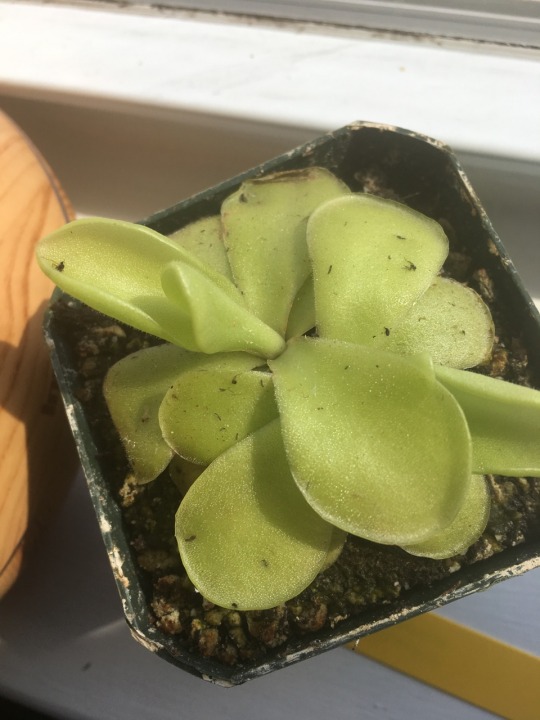
I learned something new about Doctor Mrs The Professor Ethelstein this morning!
I went to take a look at him and I noticed that the leaf where he caught a fly a few days ago had curled up a bit (for reference, that leaf is the big curled one in upper left corner).
At first I was concerned that there was something wrong with him (was he getting too much sun? Not enough humidity?) So I looked it up and it turns out that this is actually a normal behavior for certain species of Pinguicula!
Apparently certain species of Pinguicula react this way as part of the digestive process. Once a leaf has caught a fly, it curls up a bit over the course of a few days. There are a few theories behind this: to further pool digestive fluids, to keep ants from stealing their prey, or to help spread out the bug juices in order to “enhance nutrient absorption”.
Now here is the strange part: every piece of info I’ve seen on this behavior tells me that it is only seen in certain temperate species of butterwort.
Doc is an Alfred Lau #13 butterwort. Alfred Lau #13 butterworts are an unidentified kind of butterwort that is theorized be a form of or hybrid with Pinguicula gigantea (the Giant Butterwort). Alfred Lau #13 butterworts are tropical, not temperate! They’re from Mexico!
Now, from what I’ve looked at online, all species of butterwort often dimple under their prey, but this isn’t dimpling- this is full on curling!
So there are two possibilities:
1. The nursery sent me the wrong plant. I somewhat doubt this. They only carry one kind of temperate butterwort, and that was out of stock when I ordered Doc. It also looks nothing like Doc. The only plant that they could have mixed up and sent me is another tropical butterwort (specifically Pinguicula agnata) which also shouldn’t display this behavior.
2. The Alfred Lau #13 butterwort is a special butterfly of a tropical butterwort and curls it’s leaves because it heard that was all the rage in Europe.
Either way, I’m going to email the nursery and ask them about it. I’ll let you know what they say.
4 notes
·
View notes
Note
Carnivorous plants are super cool and I'd like to get some, but I don't want to kill them with my lack of experience. Would you recommend pitchers as beginner carnivorous plants, or are there other kinds that are better at surviving beginner mistakes?
The good news is that carnivorous plants are easier to care for than you'd think! And a pitcher plant like a nice hybrid nepenthes will tolerate lots of learners mistakes without dying (but it won't sprout nice mature traps either)A hybrid pitcher, a cape sundew or a tropical butterwort make great colorful starters that can be grown indoors in sunny windows with little special care other than distilled water instead of tap. Venus flytraps are one of the most common but also most fussy, they prefer more direct sun and do best as outside plants. They go dormant in winter and if you live somewhere that gets freezing temps they have to be moved inside.A great nursery called California Carnivores has excellent care info, and even divide up their catalog into sections to find something easy to grow, and will specify whether a plant does ok indoors or out. Of these plants, the pitcher plant is by far the biggest and probably the most dramatic. It does best in hanging pots.Sundews I found to be the easiest. I kept one alive for two years by doing nothing to it but watering and it only died because Aster smushed it.
43 notes
·
View notes
Photo

Kew Gardens Part IV – The Princess of Wales Conservatory
If the Palm House and Temperate House were prime examples of 19th Century engineering to support botanical study, the Princess of Wales Conservatory represents the same for 20th Century technology. Instead of one temperature throughout the greenhouse, there are ten separate, computer-controlled climatic zones. The sloping glass roof extends right to the ground, designed in a way to maximise the use of the sun's energy at whatever time of year.

Inside, the zones are grouped so that the cooler zones are around the outside, with the more tropical zones in the central area where heat is best conserved. The zones vary in size depending on the type of climate and size of the plant collections. Of the larger zones, the dry topics is well worth a visit to see the vast array of cacti, aloe, agave and lithops – including the plants responsible for tequila, and some truly murderous looking cactus spines. In the neighbouring wet tropics, housing many rainforest plants, huge water lilies can be seen floating in the pond, and the huge titan arum can be found tucked in amongst the foliage, waiting to unleash its rotten flesh-scented flower every few years.

The smaller zones contain tropical and temperate ferns, and similarly hot and cold regions for orchids. However, the highlight is possibly the two zones (again, temperate and tropical) for carnivorous plants, where sundew, butterwort, pitcher plants and Venus flytraps wait patiently for their next unwitting meals to fly into their clutches.

#london#uk#england#kew#gardens#plants#trees#kew gardens#botany#botanical gardens#greenhouse#cacti#succulents#carnivourous plants#venus fly trap#lily pad#conservatory#lundene#londinium
5 notes
·
View notes
Text

Pinguicula laueana
#indoor plants#houseplants#house plants#carnivorous plant#mexican butterwort#tropical plants#flowering plants#mexico
24 notes
·
View notes